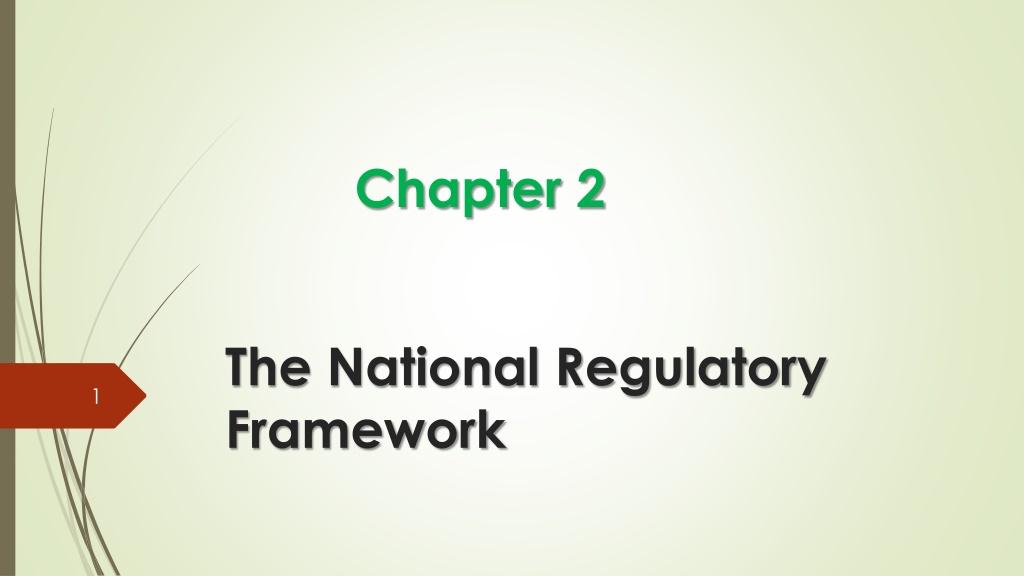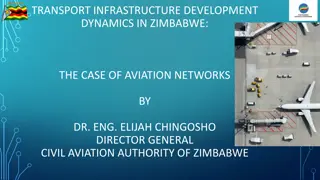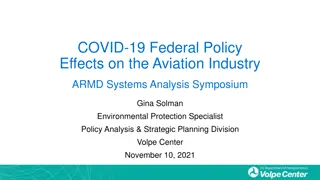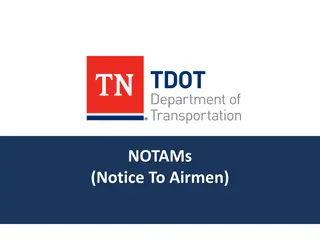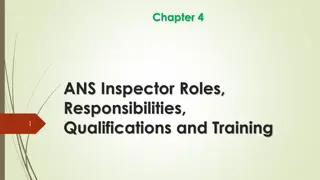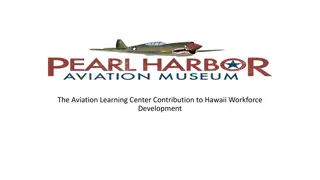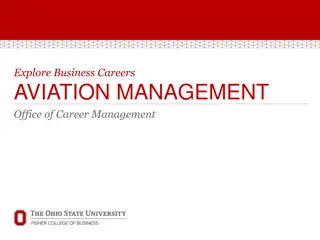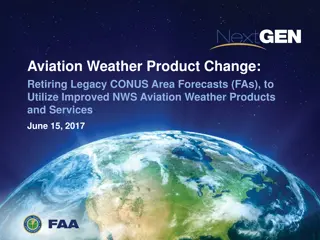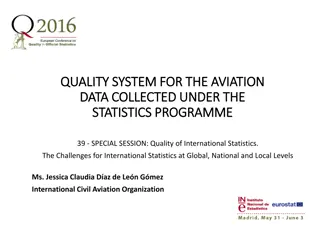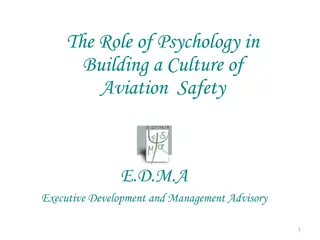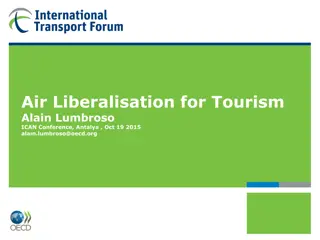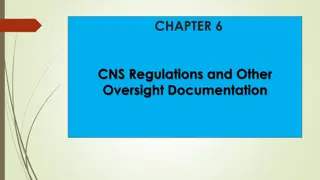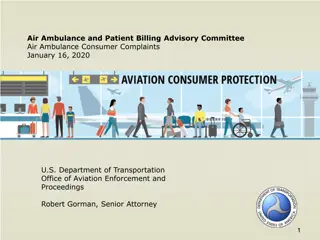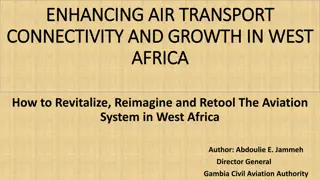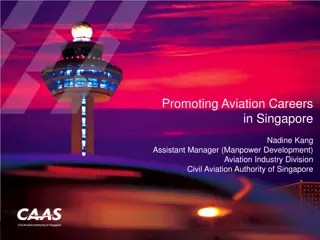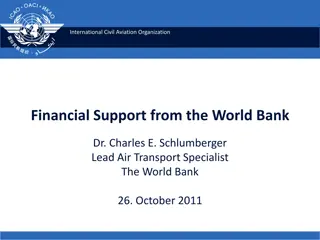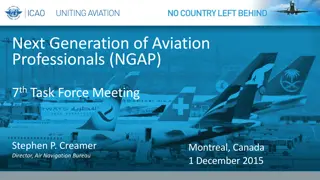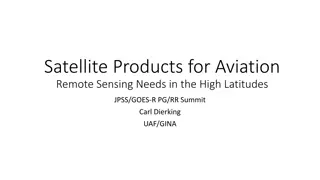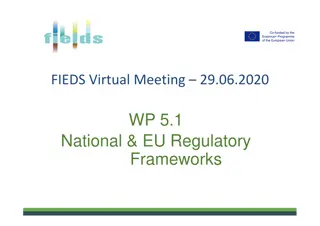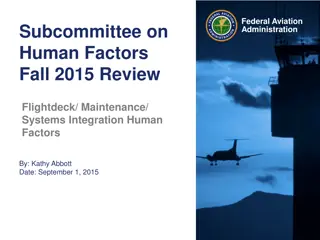The National Regulatory Framework for Aviation
This chapter delves into the importance of managing state letters, notification and publication of differences, and the development and review of primary legislation, operating regulations, and technical guidance materials in the context of aviation regulatory frameworks. It covers topics like the management of state letters, identification of differences, development of regulations, and the collaborative process involved in amending SARPs. The session aims to help participants appreciate the significance of effective regulatory management in the aviation industry.
Download Presentation

Please find below an Image/Link to download the presentation.
The content on the website is provided AS IS for your information and personal use only. It may not be sold, licensed, or shared on other websites without obtaining consent from the author.If you encounter any issues during the download, it is possible that the publisher has removed the file from their server.
You are allowed to download the files provided on this website for personal or commercial use, subject to the condition that they are used lawfully. All files are the property of their respective owners.
The content on the website is provided AS IS for your information and personal use only. It may not be sold, licensed, or shared on other websites without obtaining consent from the author.
E N D
Presentation Transcript
Chapter 2 The National Regulatory Framework 1
Learning Objectives 2 At the end of the lesson, Participants will be able to appreciate: the need for effective management of state letters; the Identification, Notification and Publication of Differences the development and review of the primary legislation, Operating Regulations and Technical Guidance Materials
Reference Documents 3 Doc 7300 The Convention on International Civil Aviation Doc 9734, Safety Oversight Manual, Part A The Establishment and Management of a State Safety Oversight System Doc 10055- Manual on Notification and Publication of Differences
Module Content 4 Management of state letters Identification, differences Development operating regulations Development and review of Technical Guidance Material notification and publication of and review of legislation and
5 Definition of The Regulatory Framework Regulatory Framework means any laws, regulations, decrees and policies officially developed and approved by the government, for the purposes of regulating a given industry.
Management of State Letters 6 Article 37:- Each contracting State undertakes to collaborate in securing the highest practicable degree of uniformity in regulations, standards, procedures, and organization . ICAO issues State letters on diverse subjects including the amendment of existing SARPS; SARPs cover all technical and operational aspects of ICAO i.e. safety, personnel licensing, rules of the air, Collection and exchange of meteorological information, Aeronautical maps and charts, Communications systems and air navigation aids and operation of aircraft etc. ICAO reviews and adopts amendments to Annexes when two- thirds of the members are in favour of such amendments.
Management of State Letters 7 Quick Revision on the SARPs Amendment process formulation of new or revised SARPs begins with a proposal for action from ICAO or from a contracting States or from international organizations. Analysis is done by the Air Navigation Commission (ANC) , or the Commission may assign its review to a specialized working group/panel/technical committee. various groups report back to the ANC original recommendations for core SARPs along with any alternative proposals developed by the ANC are submitted to Contracting States and selected international organizations for comments
Management of State Letters 8 Quick Revision on the SARPs Amendment process Council reviews final proposals of the ANC and adopts the amendment to the Annex if two-thirds of the members are in favour; States be allowed three months to indicate disapproval of adopted amendments to SARPs; A common effective date for all amendments adopted by Council is set as four months after the last day of the Council session when the adoption took place; The SARP applicability date is normally eight months after adoption and approximately four months after the effective date and is based on the November AIRAC* date; On the Applicability Date, States must implement the amendments or they notify ICAO of differences in implementation.
Management of State Letters 9 It is imperative that each state has a coordinated approach towards ensuring all communication from ICAO is received in an orderly manner, analyzed and responses generated within the provided deadlines; The following procedure may apply to a state: a) Designate an office where all communication is received i.e. the office of NCMC; b) Develop a workflow that involves the relevant departments and management; c) There could be need to establish a State Letter Management Committee comprising of representation from :
Management of State Letters 10 Legal Department, Flight Operations, Airworthiness, Personnel Licensing, Aerodromes and Ground Aids, Air Navigation Services, Security, Air Transport/Economic Regulation, Accident Investigation and Environmental protection. Adopt the Compliance Checklists (CC)/Electronic Filing of Differences (EFOD) as the primary means of filing of differences with ICAO; In situations where we have regional aviation blocks it is important that responses are harmonized;
Management of State Letters 11 Generic Procedure For Handling State Letters Designate an office or officer like the NCMC who shall access the ICAO-NET and download the state letters In some cases the regional office sends some SLs directly to states on some pertinent issues like PIRG deficiency resolution; in rare circumstances a hard copy may be received through the courier/postal dispatch; NCMC to register the downloaded state letter (or hard copy where applicable) in the Authority s State Letter Register or in cases where there is an automated file/letter management system the same should be utilized as applicable.
Management of State Letters 12 Generic Procedure For Handling State Letters NCMC to distribute the SL to the relevant Department and/or other agencies or departments involved with Civil Aviation for their information, consideration and comments; Consideration to be given to the timelines and need to compile the state position to ICAO The state letter committee to vet the input received and consolidate the final position as a report for the CEO s approval;
Management of State Letters 13 Handling ICAO State Letters Other Than Amendments Of SARPS or ICAO Documents ICAO may issue State letters on matters other than proposals for amendment of SARPs. This may include; Informing States of meetings/workshops/ seminars/ trainings; Requiring States to take certain urgent actions; Providing States with guidance on particular matters; and Any other pertinent information that ICAO may consider necessary to warrant issuance of a State letter.
Management of State Letters 14 Handling ICAO State Letters Other Than Amendments Of SARPS Or ICAO Documents These types of State letters shall be distributed depending on the subject and to the relevant department; Nominations to meetings/ workshops/ seminars/ trainings shall take cognizance of the subject matter and policy of the concerned state;
Identification, Notification and Publication Of Differences 15 In accordance with Article 37 of the Chicago Convention each Contracting State undertakes to collaborate in securing the highest practicable degree of uniformity . SARPs are adopted by the Council in accordance with Articles 37, 54 and 90 of the Chicago Convention and are designated as Annexes; Article 38 of the Chicago Convention : Any State which finds it impracticable to comply shall give immediate notification to the International Civil Aviation Organization of the differences between its own practice and that established by the international standard.
Identification, Notification and Publication Of Differences 16 A Contracting State must notify ICAO at all times a) if it does not comply with a Standard in all respects; b) does not bring its regulations or practices into full accord with any Standard; or c) adopts regulations or practices differing in any particular respect from the Standard.
Identification, Notification and Publication Of Differences 17 The following are some of the circumstances that may require the notification of a difference: a) A situation in which the State does not bring its practices into full accord with the Standard. i.e. partial implementation Adoption of annex 2 standard 2.1.1 and article 12 of the convention but no adoption of the high seas requirement in the area of jurisdiction.
Identification, Notification and Publication Of Differences 18 b) A situation in which the State s regulation (or lack thereof) differs from the Standard. Application of the standard but no incorporation of the same into the national regulations. c) A situation in which the State does not comply with a Standard in all respects ( No incorporation into its national regulations and not implemented or applied it in practice within the aviation system;
Identification, Notification and Publication Of Differences 19 States may report temporary or short-term differences (e.g. exemptions) and provide such information through other means like NOTAM or AIC in accordance with Annex 15. The notification of differences does not relieve a State of its obligations and may still result in a USOAP finding related to the specific SARP The state is required to publish the differences in the AIP (GEN 1.7) in a form that would enable a user to differentiate readily between the requirements of the State and the related ICAO provisions
Identification, Notification and Publication Of Differences 20 the publication of significant differences in the AIP is, primarily, to provide flight crews, and other stakeholders, with information which is essential to international operations, and which is not readily available;
Identification, Notification and Publication Of Differences 21 Benefits Of Notifying Differences Promotes, safety, efficiency and regularity in air navigation enhances transparency of safety information, and, consequently, facilitates States decisions specifically within the context of the management of safety. contributes to ensuring the safe and orderly growth of international civil aviation. avoid misunderstandings that may result in undesirable operational situations, or in other potential negative consequences through incorrect notification of differences.
Identification, Notification and Publication Of Differences 22 Notification of Differences Process apply to the following items: Standard. Recommended Practice - in the event of non-compliance notification to the Council is encouraged under Assembly Resolutions. Appendices - Forms part of the SARPs adopted Definitions - are an essential part of each SARP and differences should be notified. Tables and figures - These add to or illustrate a SARP and form part of the associated SARP and have the same status of a SARP and thus should be notified.
Identification, Notification and Publication Of Differences 23 When To Notify Differences. ICAO informs Contracting States by State letter, of the adoption of the amendment and requests for notification of any disapproval, and differences, before given dates; the amendment becomes effective on the effective date given in the State letter except in cases where a majority of the Contracting States have registered their disapproval with the Council. Amendments, or such parts thereof as have become effective, will become applicable on dates set by the Council. This date is mostly at the end of the year (The November AIRAC cycle date).
Identification, Notification and Publication Of Differences 24 When To Notify Differences States are expected to comply with and implement all parts of the amendment that are applicable to them. All states are encouraged to start preparing for implementation of the amendment, and notification of differences immediately. The Council defines the date by which States are requested to notify ICAO of the differences between its national regulations or practices and the amended SARPs States are requested to provide updates of the differences previously notified after each amendment, as appropriate, until the difference no longer exists.
Identification, Notification and Publication Of Differences 25 Means Of Notification Differences can be notified by a) sending to ICAO a Form on Notification of Compliance With or Differences (paper-based process), which is appended to all ICAO State letters notifying States of the adoption of an amendment; or b) through the Electronic Filing of Differences (EFOD) system at www.icao.int/usoap
Identification, Notification and Publication Of Differences 26 The ICAO EFOD system, provides additional information and functionality such as: a) the latest ICAO provisions for which a refiling of differences is required; b) remarks which can help State staff in managing compliance with individual SARPs and in passing on knowledge to incoming staff; c) statistical data which provides a big picture overview of the situation in the State; and d) differences information from other States. States are encouraged to use the EFOD system for timeliness of the notification dissemination of differences
Identification, Notification and Publication Of Differences 27 Management Of Differences States need to be properly organized and staffed with qualified personnel so as to keep the status of differences up-to-date The determination of differences require, among other things, a good knowledge and understanding of: a) ICAO requirements, guidance, templates and tools regarding notification of differences; b) national regulatory context and the corresponding SARPs; and c) national practices, namely the level of implementation of SARPs in the State.
Identification, Notification and Publication Of Differences 28 Important Points to note: a) when drafting regulations keep in mind that differences will have to be determined and notified b) it is advantageous to identify and formulate differences when the national rules are being drafted or amended; c) notification of differences represents only a fraction of the work and time needed for implementing
Identification, Notification and Publication Of Differences 29 Recommended CAA Approach To The Differences. The following procedure may apply in the notification of differences: - identify a focal point in the State. This may be an individual like the NCMC or a department or section; identify the expert units corresponding to each Annex and ensure the participation of all relevant entities and experts, including legal and technical experts; have the focal point to distribute, the State letters related to proposal for the amendment to appropriate State experts having competence for the corresponding ICAO provisions;
Identification, Notification and Publication Of Differences 30 Recommended CAA Approach To The Differences. give authority to the focal point to request from the relevant entities and experts required inputs within a particular time frame before the ICAO timeline; let the experts make entries on the positions taken to the EFOD system; and when notifying differences, the following information should be provided: i. the number of the paragraph or subparagraph as amended which contains the SARP to which the difference relates; ii. the reasons for the difference why the State does not comply with the SARP, iii. a clear and concise description of the difference; and iv. intentions for future compliance and any date by which the State plans to confirm compliance
Development Of Regulations and Technical Guidance Materials 31 Primary Legislation 1. Introduction Article 12 and 37 provides the framework for the development of regulations uniformity in compliance with the international practices; the Chicago Convention requires its Contracting States to implement and enforce the SARPs contained in the Annexes to the Convention. that will facilitate
Development Of Regulations and Technical Guidance Materials Primary Legislation 1. Introduction Cont. two prerequisites for the introduction of a regulatory system from an air navigation services perspective: the provision, in the basic aviation law of the State, for air navigation regulations and the promulgation thereof; and the establishment of an appropriate State body, with the necessary powers to ensure compliance with the regulations. 32
Development Of Regulations and Technical Guidance Materials 33 Primary Legislation 2. Requirements on Basic aviation laws The basic laws of the State relating to aviation should: a) authorize the establishment of a DGCA to be headed by a chief executive officer (Director General CA); b) make provision for the delegation of the necessary authority and the assignment of corresponding responsibility to the DGCA to develop, issue and revise operating regulations and rules consistent with the air navigation regulations;
Development Of Regulations and Technical Guidance Materials 34 Primary Legislation 2. Requirements on Basic aviation laws Cont. . The basic laws of the State relating to aviation should: c) make provision for the adoption of operating regulations and rules based on the provisions of the Annexes; d) make provision for the enforcement of the air navigation regulations and associated operating regulations and rules; and e) require all civil aviation operations to be conducted under State authority and in accordance with any conditions the State may consider applicable in the interests of safety and in accordance with all appropriate treaties and agreements between the State and other States.
Development Of Regulations and Technical Guidance Materials 35 Primary Legislation Should be commensurate with the size and complexity of the State s aviation activity and consistent with the requirements contained in the Convention (Doc 7300) Facilitate the oversight and management of civil aviation safety and the enforcement of regulations through the relevant authorities or agencies; provide for personnel performing safety oversight functions access to facilities, personnel and associated records, as applicable, of individuals and organizations performing various aviation activities;
Development Of Regulations and Technical Guidance Materials 36 Primary Legislation a legislative instrument known as the civil aviation act or other suitable title determined by the State. is applicable to all individuals and organizations subject to the laws of the State concerned. It refers to State legislation relating to the operation and navigation of such aircraft while within its territory, the registration of aircraft in the State, and the flight and maneuvering of aircraft, including all other activities
Development Of Regulations and Technical Guidance Materials 37 Primary Legislation should enable the proactive and effective regulation and supervision of the civil aviation activities. key to effective and sustainable safety oversight by the State. empowers the designated authorities to promulgate and amend, as needed, specific operating regulations. Should contain the legal basis for enforcement, including the ability to impose operating restrictions, suspend or revoke licenses, certificates, authorizations or approvals as well as impose financial penalties.
Development Of Regulations and Technical Guidance Materials 38 Primary Legislation Examples: 1. Protection of safety information Aviation safety and security information obtained, gathered voluntarily or otherwise given to the Authority under this Act or regulations made thereunder shall not be put to any inappropriate use: Provided that the Authority shall not be precluded from sharing aviation safety and security information with other Civil Aviation Authorities in the Contracting States subject to appropriate safeguards.
Development Of Regulations and Technical Guidance Materials 39 Primary Legislation Examples: 2. Suspension or revocation of privileges of a licence Where the Director-General has reasonable grounds to believe that a violation of this Act, the regulations and any other rules made thereunder has occurred, he or she may in respect of the offending entity specified under section 39, make an order to detain, prohibit, suspend, revoke or vary the privileges of a licence, certificate or any other authorization issued by the Authority
Development Of Regulations and Technical Guidance Materials 40 Primary Legislation Examples: 3. Inspection of aerodromes, premises and aircraft (1) The Authority shall inspect any aerodrome used for civil aviation operations, premises of any regulated agent or premises of the holder of an air service license, certificate, authorization or other approval document issued by the Authority or any aircraft on Kenyan territory regardless of their state of registry or Kenya registered aircraft wherever it may be for reasons of aviation safety, security, consumer protection and for any other reasons for which the Authority is established.
Development Of Regulations and Technical Guidance Materials 41 Primary Legislation Examples: (4) The Authority s inspectors shall have unhindered access to aerodromes, premises of any regulated agent or premises of the holder of air service license, certificate, authorization or other approval document or aircraft wherever it may be and the related facilities and installations and to any records, information and explanation that may be required in the course of their inspections.
Development Of Regulations and Technical Guidance Materials 42 Development Of Specific Operating Regulations Requires the promulgation of regulations to address, at a minimum, national requirements emanating from the primary aviation legislation, for standardized operational procedures, products, services, equipment and infrastructure in conformity with the Annexes ought to be comprehensive, clear, consistent and up to date. should conform with the Annexes to the Chicago Convention; Caution: Annexes are not written in a manner that supports transposing the SARPs verbatim into a State s regulations.
Development Of Regulations and Technical Guidance Materials 43 Development Of Specific Operating Regulations develop regulations which contain sufficient details that are consistent with their legal frameworks; develop and implement a process to ensure the timely amendment of the specific operating regulations, as necessary, in order to keep pace with the amendments to the Annexes system should allow the issuance of regulations at an appropriate level as provided for by the primary legislation. provide for the regulations to be repealed when replaced by new ones.
Development Of Regulations and Technical Guidance Materials 44 Development Of Specific Operating Regulations The regulations govern all relevant aspects of its civil aviation activities, including, among others, requirements leading to the issuance or validation of licenses, ratings, certificates and approvals, as appropriate. be written in a way that they can be easily understood and used by the industry as well as by the CAA staff in the execution of their day-to-day activities. regulations should be commensurate to the size and complexity of the of its industry Should avoid undue burden to the industry or state;
Development Of Regulations and Technical Guidance Materials 45 Development Of Specific Operating Regulations Regulations should be consistent and avoid contradictions and/or inconsistencies between provisions contained in different regulations in force. Point to Note: Article 40 of the Convention: if standards implemented by a State are lower than those required by ICAO, then the aircraft, air operators or personnel with licences or certificates issued or rendered valid by that State cannot participate in international air navigation, except with the permission of the State or States whose territory is entered. SARPs applicable to the air navigation services are defined in Annex 2,3,4,5,10,11,12,15 and 19.
Development Of Regulations and Technical Guidance Materials 46 Exemptions And Exceptions regulations should provide for the issuance of exemptions and exceptions; there are cases where compliance with regulatory provisions not possible; In such cases exemptions or exceptions may be granted by the State; These ought to be supported by appropriate, robust and documented safety risk assessments or aeronautical studies and imposition of limitations, conditions or mitigation measures, as appropriate.
Development Of Regulations and Technical Guidance Materials 47 Exemptions and Exceptions Should be rarely used but not a regular occurrence but granted on the basis of a robust rationale. the issuance of exceptions or exemptions that are not supported by safety risk assessments or aeronautical studies and by thorough reviews by the competent authority is not acceptable. Note: In developing regulations states shall adopt measures to ensure that every aircraft flying over or manoeuvring within its territory comply with the specific operating regulations of the state.
Development Of Regulations and Technical Guidance Materials 48 Sample Regulations On ANS
Development Of Regulations and Technical Guidance Materials 49 Sample Regulations On ANS
Development Of Regulations and Technical Guidance Materials 50 Sample Regulations On ANS
